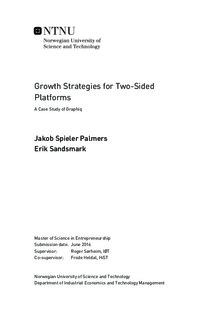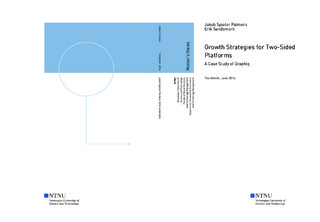| dc.description.abstract | Two-sided platforms are becoming an increasingly important part of the economy and our daily life with some of the most influential and innovative companies in the world being two-sided platforms, for example Uber, Airbnb, Alibaba, Facebook and Amazon. Two-sided platforms are characterized by a business model that creates value by facilitating interaction between two different user groups in a two-sided market. Growth of the two markets is driven by network externalities between participants in each market. A challenge every two-sided platform face is how to grow two markets simultaneously since they are dependent on each other. As two-sided platforms have fundamental differences from other business configurations, general business strategy theory is not necessarily applicable to two-sided platforms.
Cusumano (2010) states that platform competition is first and foremost won by the best strategies, not products. Understanding how platform strategies are created is therefore important. The aim of the paper is therefore to answer the research question: how to create growth strategies for two-sided platforms. To answer the research question a literature review and an empirical study have been conducted.
The literature review has unfolded 12 growth strategy categories for two-sided platforms, under which strategists can conceive specific growth strategies for their platform. Further, the literature review has been the basis for the creation of a framework consisting of four models to better understand the nature of two-sided platforms.
The empirical study has been a case study investigating the two-sided platform company Graphiq by interviewing eight of its users. Supporting data is collected from documentation, data archives and physical artifacts.
The findings from the interviews together with supporting evidence gives the basis for discussing how one can create growth strategies for Graphiq by using the theoretical framework and the 12 growth strategy categories presented. This show how strategists in general can create growth strategies for two-sided platforms. The paper concludes that this can be done in a four step process: 1) Diagnose your platform with the two-sided platform framework. 2) Analyse value creation on the two-sided platform by understanding the platform user groups, for example through interviews. 3) Conceive strategies under the 12 strategy categories based on the feedback from your users. 4) Prioritize the strategies based on your type of platform, and which phase the platform currently is in. Using the method one will be able to attract new users and grow a two- sided platform. | |

